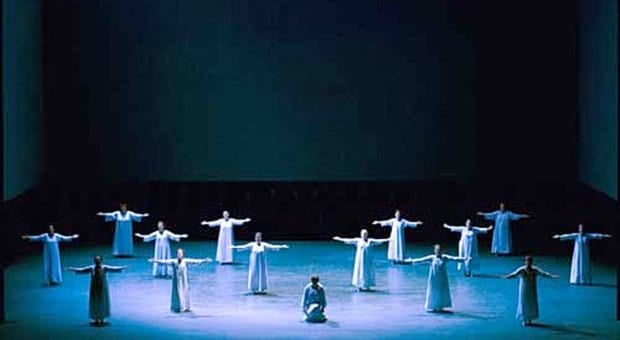Dialogues of the Carmelites (1957) by Francis Poulenc. Libretto by Poulenc based on Georges Bernanos’s play, which was based on a 1931 novel by Gertrude von Le Fort, itself based on a true story, the account of which was published as Relation by one of the Compiègne Carmelites who survived the Terror, Mother Marie of the Incarnation of God. Directed at the COC by Robert Carsen.
What happens? The French revolutionaries are closing in on a Carmelite convent, but the central drama is one of a loss of faith. Blanche de la Force, faced with the uncomplicated, joyous belief of Sister Constance, the agonizing death of the Prioress, Sister Marie`s dogged competence, and her own impending death, is losing her bearing. What if there is no redemption in dying – what if Sister Constance is wrong and we do not die for each other but singularly alone? What if no light of martyrdom will follow and the death at the guillotine is nothing but the death at the guillotine?
How much is the soprano tortured? Only by the questions of faith, loyalty and purpose, so until the last scene the pain is of the mental kind. The contralto gets the most torturous scene, in fact: the Prioress` dying is one of a rare opera death that goes for realism. Then there is the concluding scene of the opera — a mass execution. Directors usually stage it an abstract way, with absolutely no gore, but there is a propulsion and rhythmic inevitability in it that is chilling.
How much homosociality? Scratch homosocial, put gay: this is the gayest opera at the COC this season. (Though, note, completely devoid of gaiety: dead serious and gay can coexist, and the ironic distance is not a precondition for queer aesthetics.) Poulenc was as openly gay as an artist could be in France of the 1930s to 1950s and had a famously promiscuous love life as well as a firm allegiance to Catholicism. By many accounts, he composed the Carmelites as the young man that he loved lay dying of tuberculosis. “Blanche, c’est moi,” he was later quoted as saying.
The opera itself is almost all-female, and the relationships among women in it drawn with great care. Some of the recent productions – Mireille Delunsch’s at the Opéra de Bordeaux this year, for example — have made it clear that the dying Prioress was a little too attached to her favourite Blanche. The farewell scene can directly echo the state Poulenc was in when composing.
What to look for in the music? The collective prayers are particularly poignant: the requiem for the Prioress, the Ave Maria and the Ave Verum Corpus, all in Act 2, and the Salve Regina of the final scene of the opera. Among the added instruments: a second harp, a piano and, um, a guillotine. The bells will be heard during the Prioress’s death scene.
What kind of a date to invite? Anybody but a person who will take the opera as a confirmation of the superiority of our history of gradual reform versus the excessive rebelliousness and the black-and-white view of the French political culture.
Conversation starter at the intermission: This is all fine and well, but I’m now dying for an anti-dote, some Méhul, maybe his Chant du départ in the rendition of Les Jacobins — a send-off tune for the Napoleon-led army on its way to spread liberté, fraternité & égalité across Europe, non?
Dialogues of the Carmelites
Wed, May 8 – Sat, May 25
Canadian Opera Company
Four Seasons Centre
145 Queen St W
coc.ca

 Why you can trust Xtra
Why you can trust Xtra


